Geochemistry of REE and Other Critical Elements in Deep-Sea Polymetallic Nodules from Interoceanmetal (IOM) Exploration Area in Eastern Part of Clarion–Clipperton Fracture Zone, NE Pacific
Abstract
1. Introduction
2. Geological Setting and Sampling
2.1. Sampling
2.2. Sediment Composition
2.3. Pore Water Composition
3. Methods
4. Results
4.1. Morphology and Mineralogy of Nodules
4.2. Geochemistry of Nodules
4.2.1. Geochemistry of Bulk Nodules
4.2.2. SEM Analyses of Nodules
4.2.3. In Situ LA-ICP-MS Analyses of Nodules
4.2.4. Correlations
5. Discussion
5.1. Nodule Genetic Types
5.2. Behaviour of Elements in Pore Waters, Sediments, and Nodules
5.3. REE and Critical Metal Enrichment Mechanisms
5.4. Critical Elements in Nodules
6. Conclusions
Supplementary Materials
Author Contributions
Funding
Data Availability Statement
Acknowledgments
Conflicts of Interest
References
- COM (2023) 160; Regulation of the European Parliament and of the Council Establishing a Framework for Ensuring a Secure and Sustainable Supply of Critical Raw Materials and Amending Regulations (EU) 168/2013, (EU) 2018/858, 2018/1724 and (EU) 2019/1020. European Commission: Brussels, Belgium, 2023; p. 77.
- European Commission, Directorate-General for Internal Market, Industry, Entrepreneurship and SMEs; Bobba, S.; Carrara, S.; Huisman, J.; Mathieux, F.; Pavel, C. Critical Raw Materials for Strategic Technologies and Sectors in the EU: A Foresight Study; Publications Office: Luxembourg, 2020; Available online: https://data.europa.eu/doi/10.2873/58081 (accessed on 20 November 2024).
- Kato, Y.; Fujinaga, F.; Nakamura, K.; Takaya, Y.; Kitamura, K.; Ohta, J.; Toda, R.; Nakashima, T.; Iwamori, H. Deep-sea mud in the Pacific Ocean as a potential resource for rare-earth elements. Nat. Geosci. 2011, 4, 535–539. [Google Scholar] [CrossRef]
- Yasukawa, K.; Ohta, J.; Mimuraa, K.; Tanaka, E.; Takaya, Y.; Usui, Y.; Fujinaga, K.; Machida, S.; Nozaki, T.; Iijimae, K.; et al. A new and prospective resource for scandium: Evidence from the geochemistry of deep-sea sediment in the western North Pacific Ocean. Ore Geol. Rev. 2018, 120, 260–267. [Google Scholar] [CrossRef]
- Pak, S.J.; Seo, I.; Lee, K.Y.; Hyeong, K. Rare Earth Elements and Other Critical Metals in Deep Seabed Mineral Deposits: Composition and Implications for Resource Potential. Minerals 2019, 9, 3. [Google Scholar] [CrossRef]
- Ren, J.; He, G.; Yang, Y.; Yu, M.; Deng, Y.; Pang, Y.; Zhao, B.; Yao, H. Ultraselective enrichment of trace elements in seawater by Co-rich ferromanganese nodules. Glob. Planet. Chang. 2024, 239, 104498. [Google Scholar] [CrossRef]
- Hein, J.; Mitzell, K.; Koschinsky, A.; Conrad, T. Deep-ocean mineral deposits as a source of critical metals for high- and green-technology applications: Comparison with land-based resources. Ore Geol. Rev. 2013, 51, 1–14. [Google Scholar] [CrossRef]
- Volkmann, S.E.; Kuhn, T.; Lehnen, F. A comprehensive approach for a techno-economic assessment of nodule mining in the deep sea. Miner. Econ. 2018, 31, 319–336. [Google Scholar] [CrossRef]
- Abramowski, T.; Urbanek, M.; Baláž, P. Economic Assessment of Polymetallic Nodules Mining Project with Updates to Present Market Conditions. Minerals 2021, 11, 311. [Google Scholar] [CrossRef]
- Stoyanova, V.; Hikov, A.; Stefanova, E.; Milakovska, Z.; Abramowski, T.; Peytcheva, I.; Chavdarova, S.; Stavrev, M. Deep-sea polymetallic nodules as opportunity for future supply with critical raw materials. Rev. Bulg. Geol. Soc. 2021, 82, 153–155. [Google Scholar] [CrossRef]
- Halbach, P.; Scherhag, C.; Hebisch, U.; Marchig, V. Geochemical and mineralogical control of different genetic types of deep-sea nodules from the Pacific Ocean. Miner. Depos. 1981, 16, 59–84. [Google Scholar] [CrossRef]
- Kotliński, R.A. Metallogenesis of the World’s ocean against the background of oceanic crust evolution. Pol. Geol. Inst. Warszawa 1999, 4, 1–59. [Google Scholar]
- Kotlinski, R.; Stoyanova, V. Nodule coverage, morphology and distribution in the Eastern CCZ. In ISA, Technical Study No 6: Prospector’s Guide for Polymetallic Nodule Deposits in the Clarion-Clipperton Fracture Zone; International Seabed Authority: Kingston, Jamaica, 2010; pp. 34–42. [Google Scholar]
- Hikov, A.; Milakovska, Z.; Stoyanova, V.; Stefanova, E.; Abramowski, T.; Chavdarova, S.; Stavrev, M. REE and trace elements distribution in the deep-sea sediments from the Interoceanmetal (IOM) polymetallic nodule exploration area in the Clarion-Clipperton fractures zone, NE Pacific. Compt. Rend. Acad. Bulg. Sci. 2022, 75, 1018–1027. [Google Scholar] [CrossRef]
- Milakovska, Z.; Hikov, A.; Stoyanova, V.; Peytcheva, I.; Lyubomirova, V.; Abramowski, T. REY in pore waters of sediments hosting Fe-Mn nodules of the Interoceanmetal exploration area in the Clarion-Clipperton Fracture Zone, NE Pacific. Geol. Balc. 2022, 51, 27–35. [Google Scholar] [CrossRef]
- Milakovska, Z.; Hikov, A.; Stoyanova, V.; Peytcheva, I.; Abramowski, T. Trace element characteristics of pore water from the deep-sea sediments of the Interoceanmetal exploration area in the Clarion-Clipperton Fracture Zone, NE Pacific. Rev. Bulg. Geol. Soc. 2023, 84, 129–132. [Google Scholar] [CrossRef]
- Baláž, P. Results of the second phase of deep-sea polymetallic nodules geological survey in Interoceanmetal Joint Organization licence area (2016–2021). Miner. Slovaca 2022, 54, 95–118. [Google Scholar] [CrossRef]
- Kotliński, R. Sediments in the eastern CCZ. In ISA, Technical Study No 6: Prospector’s Guide for Polymetallic Nodule Deposits in the Clarion-Clipperton Fracture Zone; International Seabed Authority: Kingston, Jamaica, 2010; pp. 43–52. ISBN 978-976-95268-2-2. [Google Scholar]
- Baláž, P. Results of the first phase of the deep-sea polymetallic nodules geological survey in the Interoceanmetal Joint Organization licence area (2001–2016). Miner. Slovaca 2021, 53, 3–36. [Google Scholar]
- Skowronek, A.; Maciag, L.; Zawadzki, D.; Strzelecka, A.; Baláž, P.; Mianowicz, K.; Abramowski, T.; Koněcný, P.; Krawcewicz, A. Chemostratigraphic and Textural Indicators of Nucleation and Growth of Polymetallic Nodules from the Clarion-Clipperton Fracture Zone (IOM Claim Area). Minerals 2021, 11, 868. [Google Scholar] [CrossRef]
- International Seabed Authority. Available online: https://www.isa.org.jm/maps/interoceanmetal-joint-organization (accessed on 23 August 2024).
- ISBA/19/LTC/8; Recommendations for the Guidance of Contractors for the Assessment of the Possible Environmental Impacts Arising from Exploration for Marine Minerals in the Area. Issued by the Legal and Technical Commission 13-24713; International Seabed Authority: Kingston, Jamaica, 2013; p. 32. Available online: https://www.isa.org.jm/documents/isba19ltc8 (accessed on 15 July 2023).
- Milakovska, Z.; Stoyanova, V.; Hikov, A.; Abramowski, T.; Stefanova, E.; Peytcheva, I.; Chavdarova, S.; Stavrev, M. Depositional setting of the deep-sea sediments from an area of high nodule occurrence in the Clarion-Clipperton Fractures Zone, NE Pacific. In Proceedings of the Goldschmidt Conference 2021, Lyon, France, 4–9 July 2021. Abstract 5983. [Google Scholar] [CrossRef]
- Krumbein, W.C. Application of logarithmic moments to size-frequency distributions of sediments. J. Sed. Petrol. 1936, 6, 35–47. [Google Scholar] [CrossRef]
- Lisitzin, A.P. Sedimentation in the World Oceans; SEPM Special Publication 17; Rodolfo, K., Ed.; Society of Economic Paleontologists and Mineralogists: Tulsa, OK, USA, 1972; p. 218. [Google Scholar]
- Bostrom, K. The origin and fate of ferromanganese active ridge sediments. International Seabed Authority. Stockh. Contrib. Geol. 1973, 27, 149–243. [Google Scholar]
- Guillong, M.; Meier, D.; Allan, M.; Heinrich, C.; Yardley, B. SILLS: A MATLAB-based program for the reduction oflaser ablation ICP-MS data of homogeneous materials and inclusions. In Mineralogical Association of Canada, Short Course 40; Sylvester, P., Ed.; Mineralogical Association of Canada: Vancouver, BC, Canada, 2008; pp. 328–333. [Google Scholar]
- Post, J.E.; McKeown, D.A.; Heaney, P.J. Raman spectroscopy study of manganese oxides: Tunnel structures. Am. Mineral. 2020, 105, 1175–1190. [Google Scholar] [CrossRef]
- Dreiseitl, I. About geotechnical properties of the deep seabed polymetallic nodules. In Proceedings of the 18th International Conference on Transport and Sedimentation of Solid Particles, Prague, Czech Republic, 11–15 September 2017; p. 8. [Google Scholar]
- Sun, S.; McDonough, W. Chemical and isotopic systematics of oceanic basalts: Implications for mantle compozition and processes. Geol. Soc. Lond. Spec. Publ. 1989, 42, 313–345. [Google Scholar] [CrossRef]
- McLennan, S.M. Rare earth elements in sedimentary rocks: Influence of provenance and sedimentary processes. Rev. Mineral. 1989, 21, 169–200. [Google Scholar]
- Johnson, E.; Post, J. Water in the interlayer region of birnessite: Importance in cation exchange and structural stability. Am. Mineral. 2006, 91, 609–618. [Google Scholar] [CrossRef]
- Kotliński, R.; Stoyanova, V. Buried and Surface Polymetallic Nodule Distribution in the Eastern Clarion-Clipperton Zone: Main distinctions and similarities. Adv. Geosci. 2007, 9, 67–74. [Google Scholar] [CrossRef]
- Bonatti, E.; Kraemer, T.; Rydell, H. Classification and genesis of submarine ironmanganese deposits. In Ferromanganese Deposits on the Ocean Floor; Horn, D., Ed.; The US National Science Foundation: Washington, DC, USA, 1972; pp. 149–165. [Google Scholar]
- Josso, P.; Pelleter, E.; Pourret, O.; Fouquet, Y.; Etoubleau, J.; Cheron, S.; Bollinger, C. A new discrimination scheme for oceanic ferromanganese deposits using high field strength and rare earth elements. Ore Geol. Rev. 2017, 87, 3–15. [Google Scholar] [CrossRef]
- Bau, M.; Schmidt, K.; Koschinsky, A.; Hein, J.; Kuhn, T.; Usui, A. Discriminating between different genetic types of marine ferro-manganese crusts and nodules based on rare earth elements and yttrium. Chem. Geol. 2014, 381, 1–9. [Google Scholar] [CrossRef]
- Wegorzewski, A.; Kuhn, T. The influence of suboxic diagenesis on the formation of manganese nodules in the Clarion Clipperton nodule belt of the Pacific Ocean. Mar. Geol. 2014, 357, 123–138. [Google Scholar] [CrossRef]
- Hein, J.; Koschinsky, A.; Kuhn, T. Deep-ocean polymetallic nodules as a resource for critical materials. Nat. Rev. Earth Environ. 2020, 1, 158–169. [Google Scholar] [CrossRef]
- Dubinin, A. Geochemistry of Rare Earth Elements in the ocean. Lithol. Miner. Resour. 2004, 39, 289–307. [Google Scholar] [CrossRef]
- Elderfield, H.; Greaves, M. Negative cerium anomalies in the rare earth element patterns of oceanic ferromanganese nodules. Earth Planet. Sci. Lett. 1981, 55, 163–170. [Google Scholar] [CrossRef]
- Kuhn, T.; Bau, M.; Blum, N.; Halbach, P. Origin of negative Ce anomalies in mixed hydrothermal–hydrogenetic Fe–Mn crusts from the Central Indian Ridge. Earth Planet. Sci. Lett. 1998, 163, 207–220. [Google Scholar] [CrossRef]
- Hein, J.; Koschinsky, A. Deep-Ocean Ferromanganese Crusts and Nodules. In Treatise on Geochemistry, 2nd ed.; Elsevier: Amsterdam, The Netherlands, 2014; Volume 13, pp. 273–291. [Google Scholar] [CrossRef]
- Kuhn, T.; Wegorzewski, A.; Rühlemann, C.; Vink, A. Composition, Formation, and Occurrence of Polymetallic Nodules. In Deep-Sea Mining Resource Potential, Technical and Environmental Considerations; Sharma, R., Ed.; Springer: Berlin/Heidelberg, Germany, 2017; pp. 23–64. [Google Scholar]
- Glasby, G.P. Manganese deposition through geological time: Dominance of the Post-Eocene environment. Ore Geol. Rev. 1988, 4, 135–144. [Google Scholar] [CrossRef]
- Demidova, T. The physical environmental in nodule provinces of the deep sea. In Deep-Seabed Polymetallic Nodule Exploration: Development of Environmental Guidelines; International Seabed Authority: Kingston, Jamaica, 1998; pp. 79–116. [Google Scholar]
- Dutkiewicz, A.; Judge, A.; Müller, D. Environmental predictors of deep-sea polymetallic nodule occurrence in the global ocean. Geology 2020, 48, 293–297. [Google Scholar] [CrossRef]
- Morgan, C.L. Resource Estimates of the Clarion-Clipperton Manganese Nodule Deposits. In Handbook of Marine Mineral Deposits; Cronan, D.S., Ed.; CRC Press: Boca Raton, FL, USA, 2000; pp. 145–170. [Google Scholar]
- Glasby, G.P. Manganese: Predominant Role of Nodules and Crusts. In Marine Geochemistry, 2nd Revised, Updated and Extended Edition; Schulz, H., Zabel, M., Eds.; Springer: New York, NY, USA, 2006; pp. 371–428. [Google Scholar]
- Li, Y.-H.; Schoonmaker, J.E. Chemical Composition and Mineralogy of Marine Sediments. In Treatise on Geochemistry, 2nd ed.; Elsevier: Amsterdam, The Netherlands, 2014; Volume 9, pp. 1–35. [Google Scholar] [CrossRef]
- Deng, Y.; Ren, J.; Guo, Q.; Cao, J.; Wang, H.; Liu, C. Rare earth element geochemistry characteristics of seawater and porewater from deep sea in western Pacific. Sci. Rep. 2017, 7, 16539. [Google Scholar] [CrossRef] [PubMed]
- Ren, J.; Liu, Y.; Wang, F.; He, G.; Deng, X.; Wei, Z.; Yao, H. Mechanism and Influencing Factors of REY Enrichment in Deep-Sea Sediments. Minerals 2021, 11, 196. [Google Scholar] [CrossRef]
- Ren, J.; Jiang, X.; He, G.; Wang, F.; Yang, T.; Luo, S.; Deng, Y.; Zhou, J.; Deng, X.; Yao, H.; et al. Enrichment and sources of REY in phosphate fractions: Constraints from the leaching of REY-rich deep-sea sediments. Geochim. Cosmochim. Acta 2022, 335, 155–168. [Google Scholar] [CrossRef]
- Bau, M.; Koschinsky, A. Oxidative scavenging of cerium on hydrous Fe oxide: Evidence from the distribution of rare earth elements and yttrium between Fe oxides and Mn oxides in hydrogenetic ferromanganese crusts. Geochem. J. 2009, 43, 37–47. [Google Scholar] [CrossRef]
- Koeppenkastrop, D.; De Carlo, E.H. Sorption of rare-earth elements from seawater onto synthetic mineral particles: An experimental approach. Chem. Geol. 1992, 95, 251–263. [Google Scholar] [CrossRef]
- Jiang, X.-D.; Sun, X.-M.; Chou, Y.-M.; Hein, J.R.; He, G.-W.; Fu, Y.; Li, D.-F.; Liao, J.-L.; Ren, J.-B. Geochemistry and origins of carbonate fluorapatite in seamount Fe-Mn crusts from the Pacific Ocean. Mar. Geol. 2020, 423, 106135. [Google Scholar] [CrossRef]
- Surya Prakash, L.; Ray, D.; Paropkari, A.L.; Mudholkar, A.V.; Satyanarayanan, M.; Sreenivas, B.; Chandrasekharam, D.; Kota, D.; Kamesh Raju, K.A.; Kaisary, S.; et al. Distribution of REEs and yttrium among major geochemical phases of marine Fe–Mn-oxides: Comparative study between hydrogenous and hydrothermal deposits. Chem. Geol. 2012, 312–313, 127–137. [Google Scholar] [CrossRef]
- Koschinsky, A.; Halbach, P. Sequential leaching of marine ferromanganese precipitates: Genetic implications. Geochim. Cosmochim. Acta 1995, 59, 5113–5132. [Google Scholar] [CrossRef]
- Hikov, A.; Milakovska, Z.; Lyubomirova, V.; Lihareva, N. REE distribution in sequential leached phases from deep-sea polymetallic nodules and sediments. Rev. Bulg. Geol. Soc. 2023, 84, 105–108. [Google Scholar] [CrossRef]
- Hikov, A.; Milakovska, Z.; Lyubomirova, V.; Lihareva, N. Critical elements in sequential leached phases from deep-sea polymetallic nodules and sediments. In Proceedings of the 24rd International Multidisciplinary Scientific GeoConference SGEM 2024, Albena, Bulgaria, 28 June–8 July 2024; pp. 37–44. [Google Scholar] [CrossRef]
- Post, J.E. Manganese oxide minerals: Crystal structures and economic and environmental significance. Proc. Natl. Acad. Sci. USA 1999, 96, 3447–3454. [Google Scholar] [CrossRef] [PubMed]
- Huang, S.; Fu, Y. Enrichment Characteristics and Mechanisms of Critical Metals in Marine Fe-Mn Crusts and Nodules: A Review. Minerals 2023, 13, 1532. [Google Scholar] [CrossRef]
- Zawadzki, D.; Maciag, Ł.; Abramowski, T.; McCartney, K. Fractionation Trends and Variability of Rare Earth Elements and Selected Critical Metals in Pelagic Sediment from Abyssal Basin of NE Pacific (Clarion-Clipperton Fracture Zone). Minerals 2020, 10, 320. [Google Scholar] [CrossRef]
- Menendez, A.; James, R.; Lichtschlag, A.; Connelly, D.; Peel, K. Controls on the chemical composition of ferromanganese nodules in the Clarion-Clipperton Fracture Zone, eastern equatorial Pacific. Mar. Geol. 2019, 409, 1–14. [Google Scholar] [CrossRef]
- Sa, R.; Sun, X.; He, G.; Xu, L.; Pan, Q.; Liao, J.; Zhu, K.; Deng, X. Enrichment of rare earth elements in siliceous sediments under slow deposition: A case study of the central North Pacific. Ore Geol. Rev. 2018, 94, 12–23. [Google Scholar] [CrossRef]
- Abbott, A.; Löhr, S.; Trethewy, M. Are Clay Minerals the Primary Control on the Oceanic Rare Earth Element Budget? Front. Mar. Sci. 2019, 6, 504. [Google Scholar] [CrossRef]
- Dimitrova, D.; Milakovska, Z.; Peytcheva, I.; Stefanova, E.; Stoyanova, V.; Abramowski, T.; Waelle, M. Trace element and REY composition of polymetallic nodules from the Eastern Clarion–Clipperton Zone determined by in-situ LA-ICP-MC analyses. Compt. Rend. Acad. Bulg. Sci. 2014, 67, 267–274. [Google Scholar]
- Kozlowska-Roman, A.; Mikulski, S. Chemical and morphological characterization of polymetallic (Mn-Fe) nodules from the Clarion-Clipperton Zone in the Pacific Ocean. Geol. Q. 2021, 65, 57. [Google Scholar] [CrossRef]
- Hein, J.; Spinardi, F.; Okamoto, N.; Mizell, L.; Thorburnc, D.; Tawake, A. Critical metals in manganese nodules from the Cook Islands EEZ, abundances and distributions. Ore Geol. Rev. 2015, 68, 97–116. [Google Scholar] [CrossRef]
- Ren, J.; He, G.; Deng, X.; Deng, X.; Yang, Y.; Yao, H.; Yang, S. Metallogenesis of Co-rich ferromanganese nodules in the northwestern Pacific: Selective enrichment of metallic elements from seawater. Ore Geol. Rev. 2022, 143, 104778. [Google Scholar] [CrossRef]
- Halbach, P.; Jahn, A. Concentrations and metal potentials of REEs in marine polymetallic nodule and Co-rich crust deposits. In Deep Sea Mining Value Chain: Organization, Technology, Development; Abramowski, T., Ed.; Interoceanmetal Joint Organization: Szczecin, Poland, 2016; pp. 119–131. [Google Scholar]
- Ohta, A.; Kawabe, I. REE(III) adsorption onto Mn dioxide (δ-MnO2) and Fe oxyhydroxide: Ce(III) oxidation by δ-MnO2. Geochim. Cosmochim. Acta 2001, 65, 695–703. [Google Scholar] [CrossRef]
- Ren, Y.; Sun, X.; Guan, Y.; Xiao, Z.; Liu, Y.; Liao, J.; Guo, Z. Distribution of Rare Earth Elements plus Yttrium among Major Mineral Phases of Marine Fe-Mn Crusts from the South China Sea and Western Pacific Ocean: A Comparative Study. Minerals 2019, 9, 8. [Google Scholar] [CrossRef]
- Mohwinkel, D.; Kleint, C.; Koschinsky, A. Phase associations and potential selective extraction methods for selected high- tech metals from ferromanganese nodules and crusts with siderophores. Appl. Geochem. 2014, 43, 13–21. [Google Scholar] [CrossRef]
- Khripounoff, A.; Caprais, J.; Crassous, P.; Etoubleau, J. Geochemical and biological recovery of the disturbed seafloor in polymetallic nodule fields of the Clipperton-Clarion Fracture Zone (CCFZ) at 5,000-m depth. Limnol. Oceanogr. 2006, 51, 2033–2041. [Google Scholar] [CrossRef]
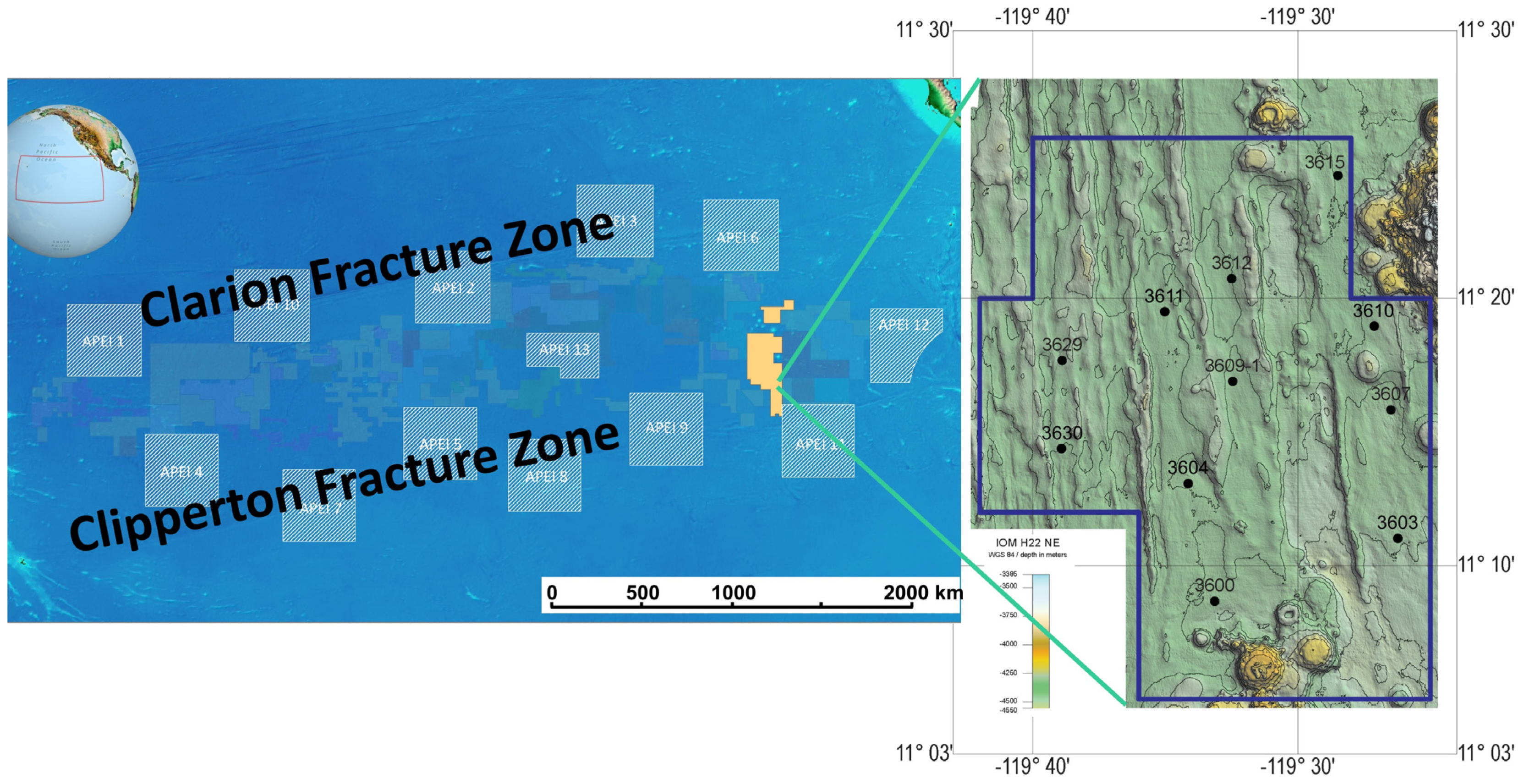
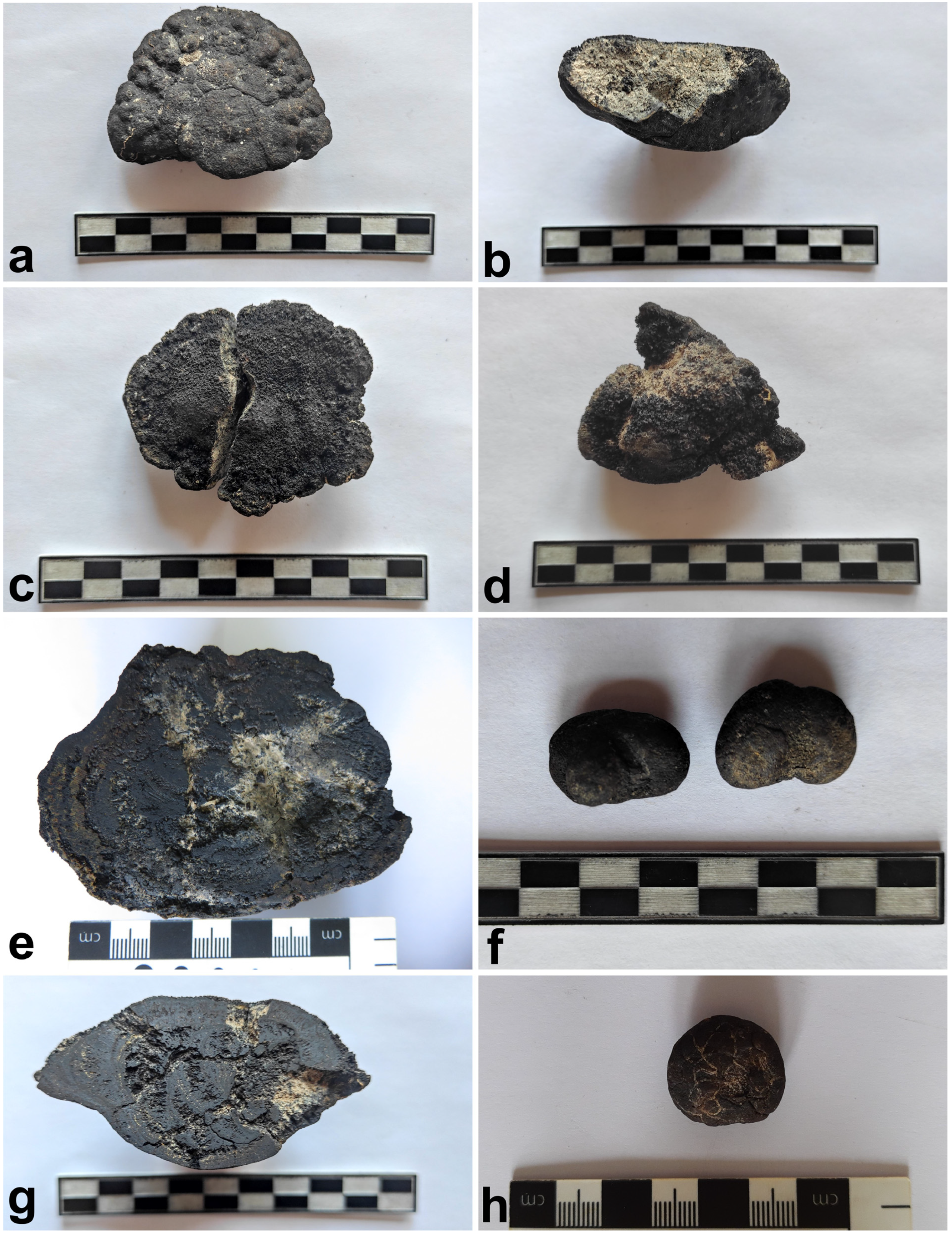
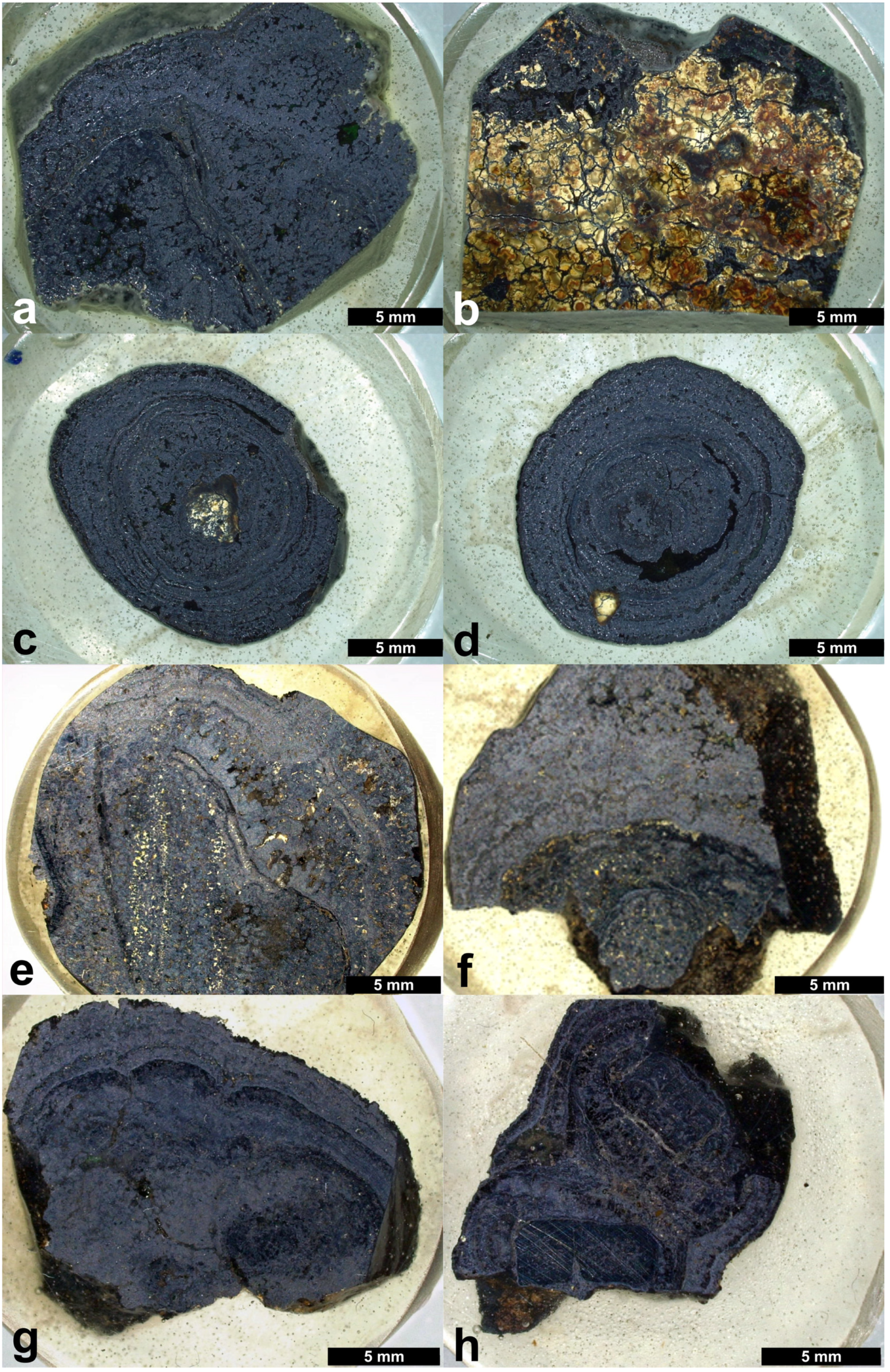
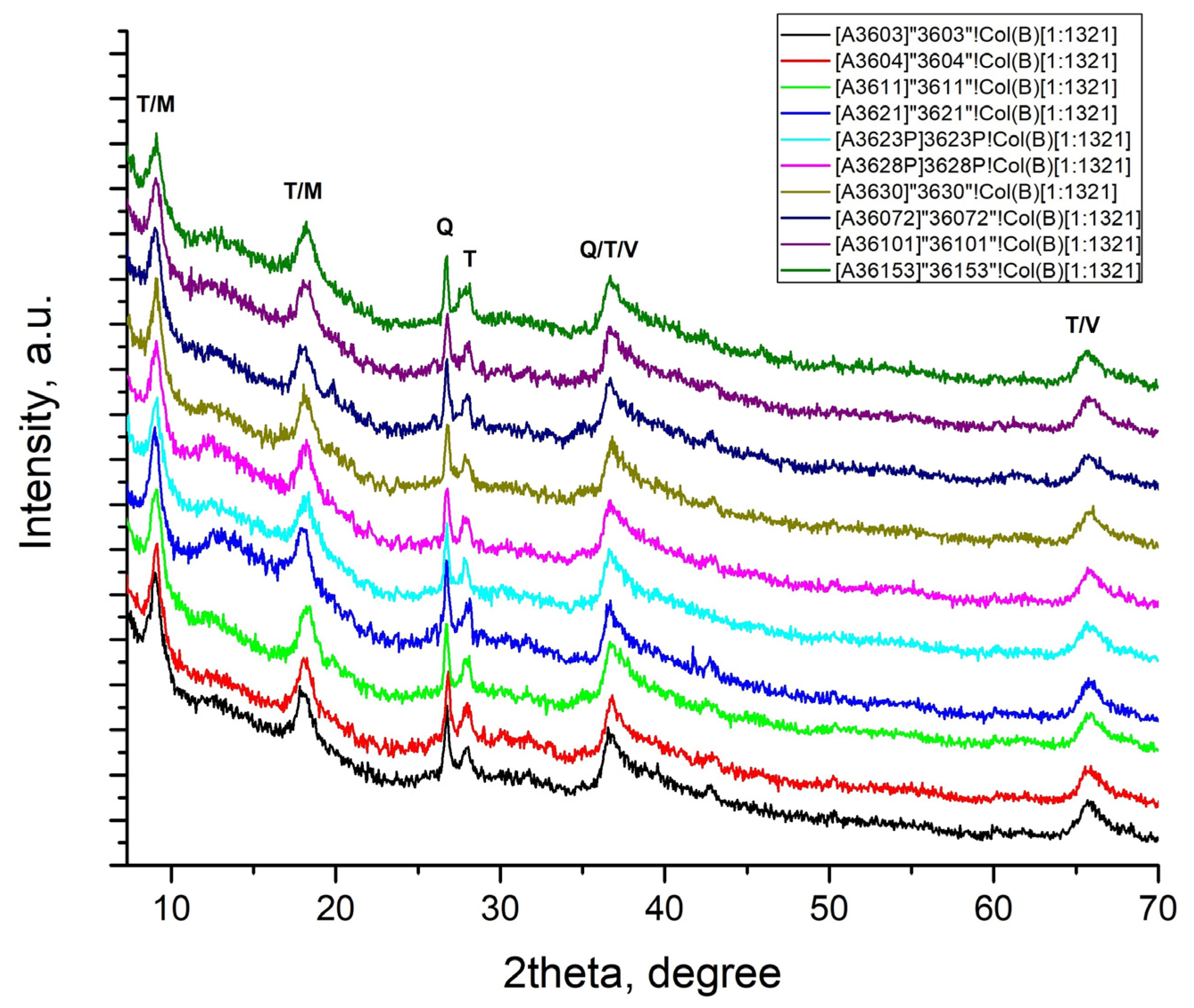
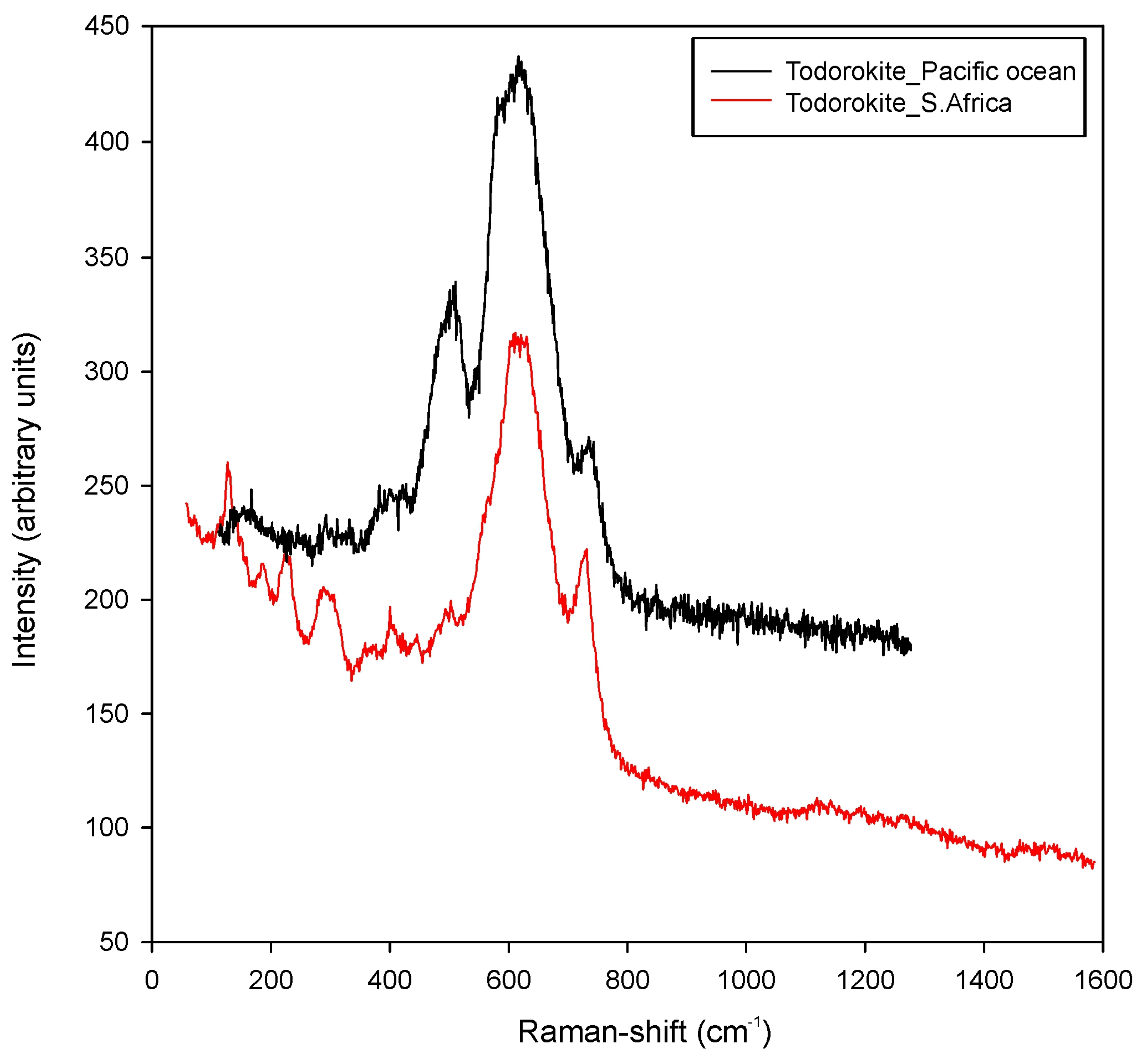
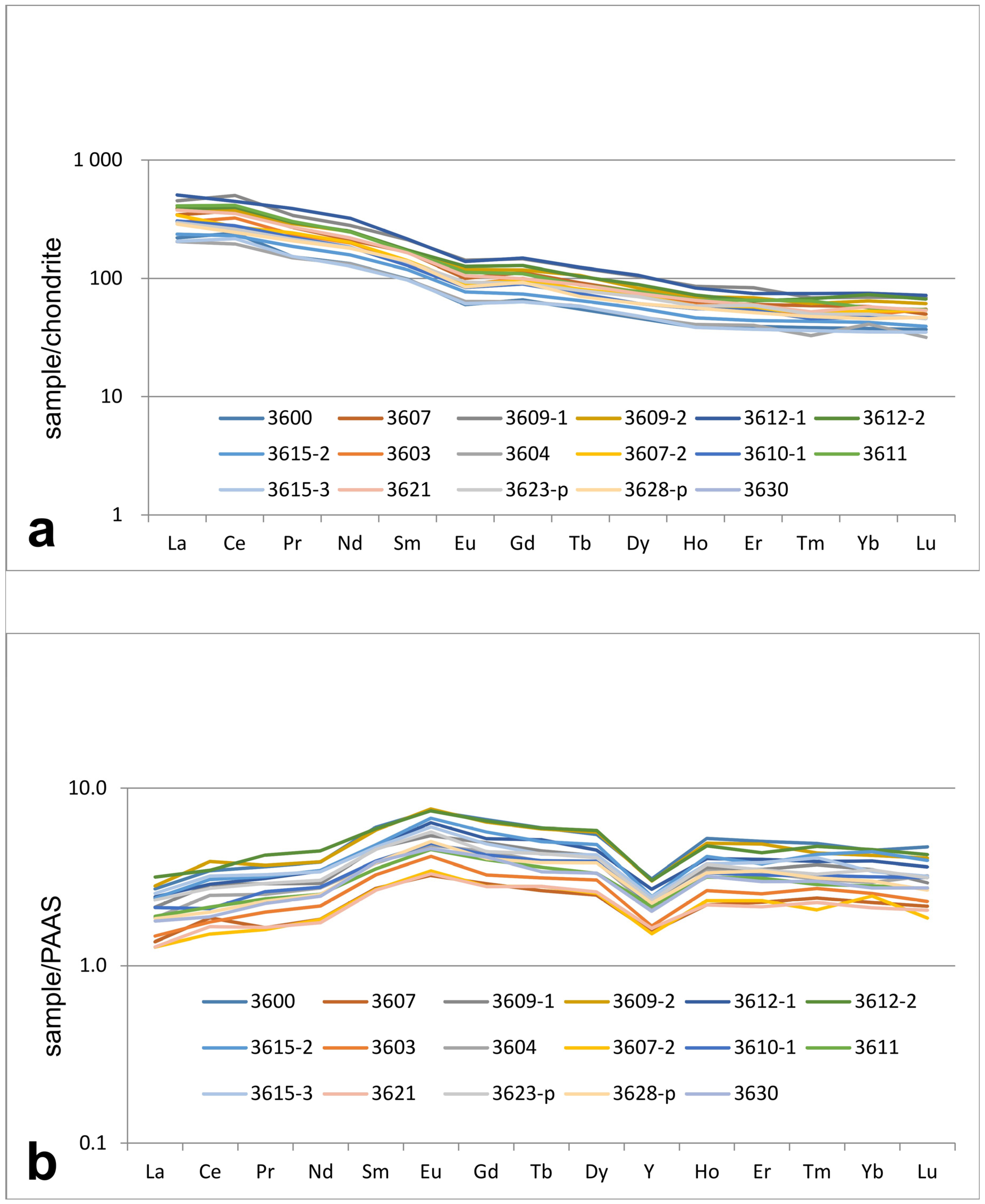
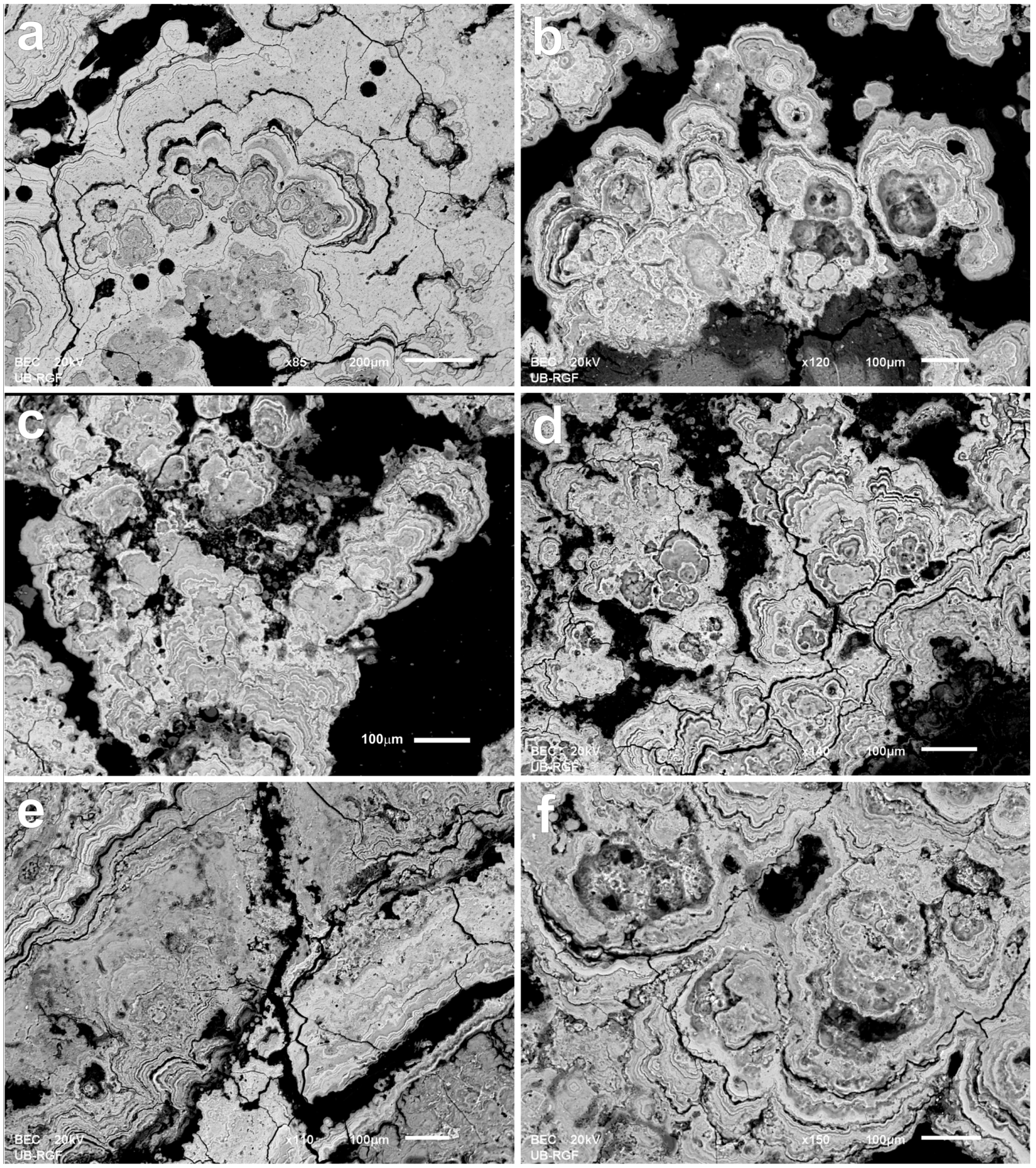
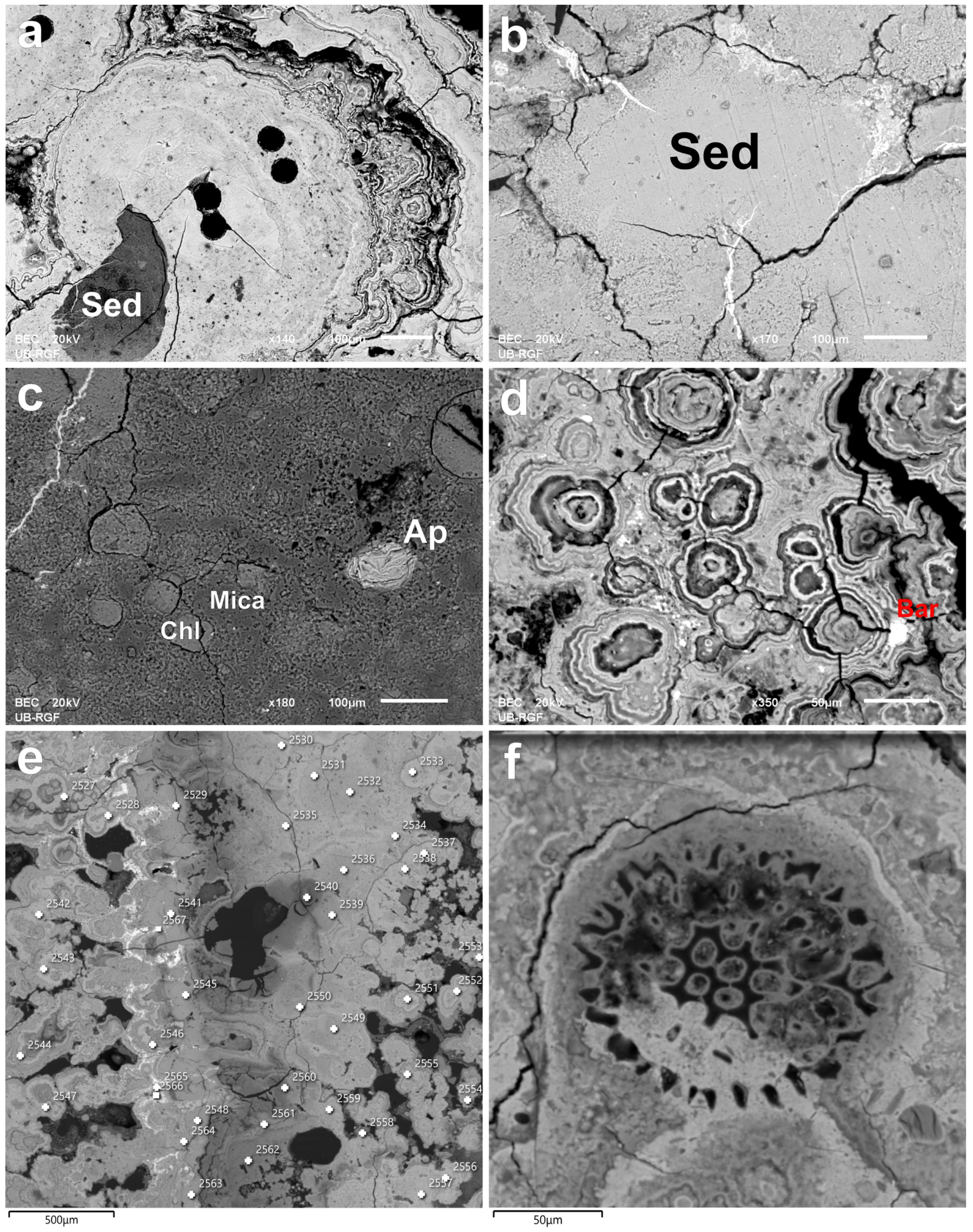




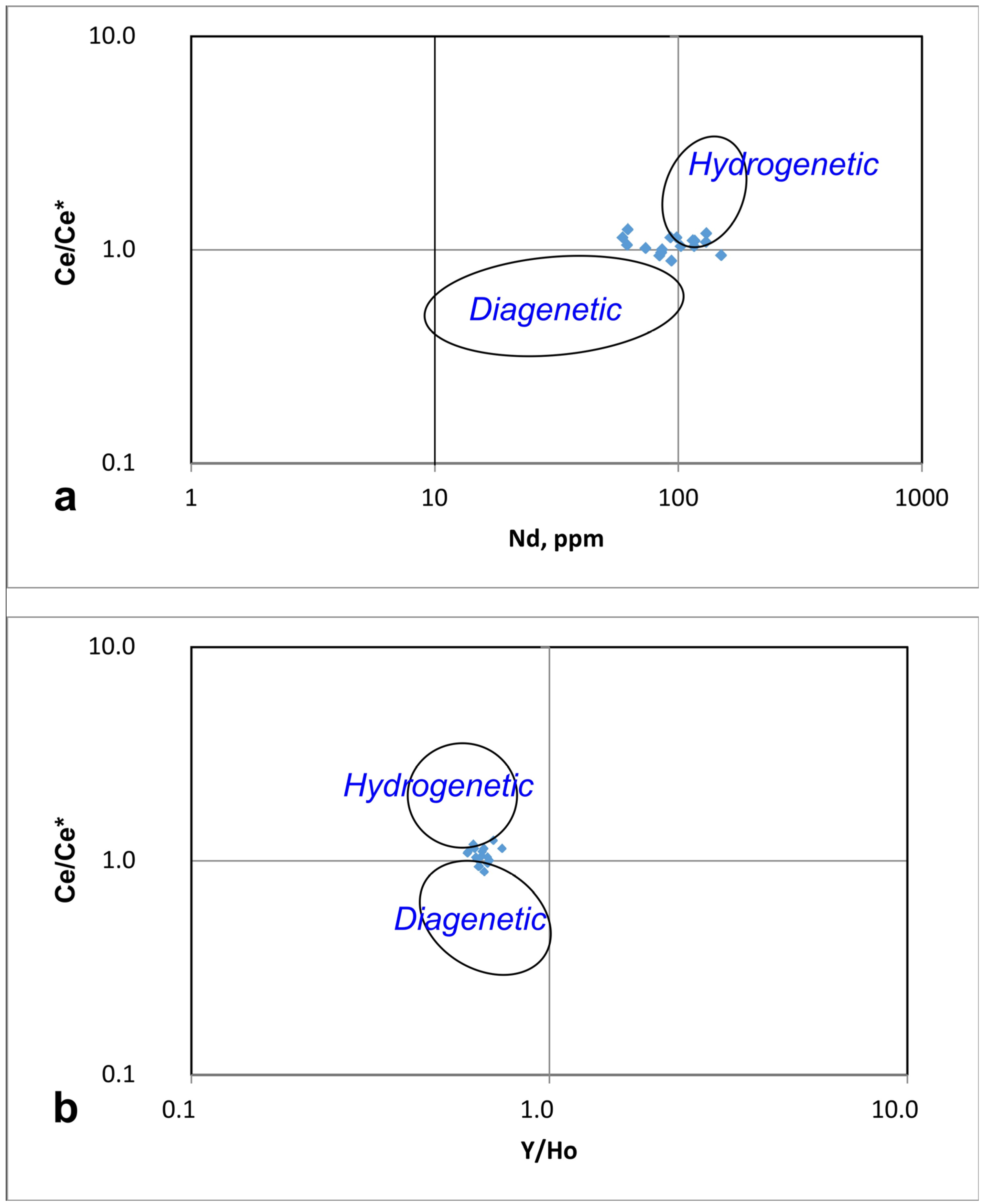
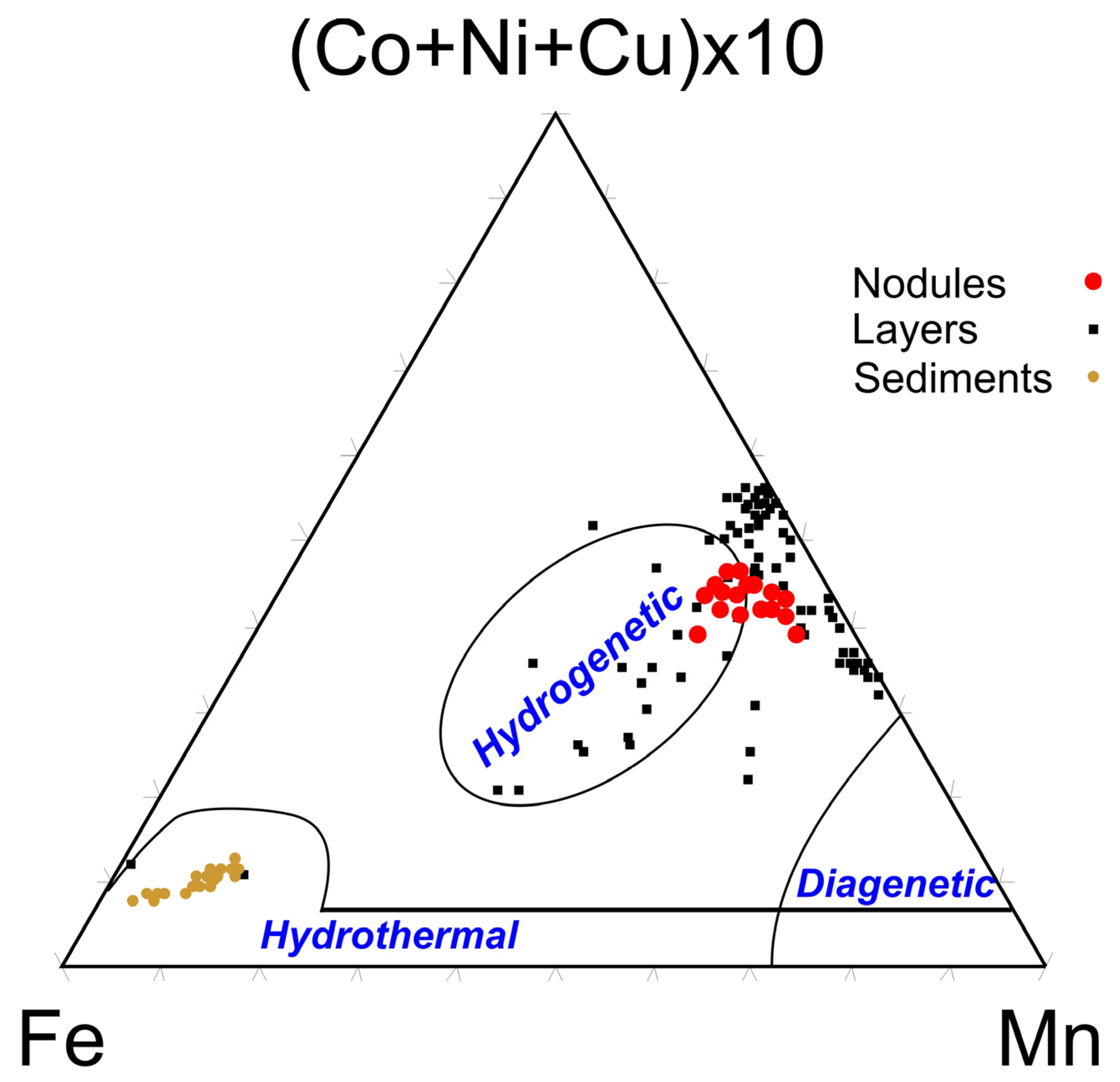

| Min | Max | Mean | Min | Max | Mean | ||
|---|---|---|---|---|---|---|---|
| Mn, % | 22.62 | 35.59 | 30.61 | Ba, ppm | 2197.00 | 5775.00 | 3526.00 |
| Fe | 3.47 | 8.26 | 5.58 | La | 48.53 | 120.65 | 79.56 |
| Cu | 1.07 | 1.50 | 1.26 | Ce | 119.66 | 307.12 | 200.70 |
| Ni | 0.58 | 1.70 | 1.29 | Pr | 14.10 | 37.04 | 23.78 |
| Co | 0.12 | 0.30 | 0.21 | Nd | 59.23 | 150.11 | 97.52 |
| Zn | 0.09 | 0.26 | 0.18 | Sm | 14.76 | 33.39 | 23.17 |
| Li, ppm | 77.00 | 205.00 | 142.50 | Eu | 3.49 | 8.25 | 5.76 |
| Sc | 5.26 | 12.87 | 8.48 | Gd | 12.99 | 31.06 | 21.13 |
| V | 381.00 | 595.00 | 473.00 | Tb | 2.05 | 4.63 | 3.23 |
| Ga | 26.40 | 51.6. | 39.10 | Dy | 11.71 | 27.05 | 18.58 |
| As | 67.00 | 158.00 | 108.00 | Ho | 2.18 | 5.17 | 3.49 |
| Sr | 431.00 | 656.00 | 567.00 | Er | 6.13 | 14.32 | 9.74 |
| Y | 41.00 | 83.00 | 61.00 | Tm | 0.83 | 1.98 | 1.38 |
| Zr | 110.00 | 340.00 | 218.00 | Yb | 5.97 | 12.73 | 9.27 |
| Mo | 430.00 | 872.00 | 737.00 | Lu | 0.80 | 2.02 | 1.34 |
| Pd | 0.34 | 1.53 | 0.88 | W | 55.00 | 111.00 | 72.00 |
| Cd | 8.61 | 24.22 | 18.23 | Tl | 53.00 | 410.00 | 226.00 |
| Sn | 0.63 | 9.52 | 5.21 | Pb | 247.00 | 616.00 | 397.00 |
| Sb | 35.00 | 67.5 | 53.60 | Bi | 2.22 | 7.07 | 4.40 |
| Te | 2.75 | 10.29 | 5.65 | Th | 4.72 | 14.54 | 9.10 |
| Cs | 1.91 | 187.5 | 20.7 | U | 2.61 | 4.58 | 3.53 |
| Matrix | Pore Waters | Sediments | Bulk Nodules | Nodule Layers | ||||
|---|---|---|---|---|---|---|---|---|
| corr | + | − | + | − | + | − | + | − |
| Mn | Al, Fe, Co, Y Cu | Co, Ni, Cu Zn, Mo, W, Na, Sr Sb, Ba | Ti, Pb, Al, Fe K | Sn, Sb, Li, Ni, Zn, Mo, Cu, V, Cd, Ba Tl | Si, Al, Fe, Na, K, Sc, Co, Ge, Rb, Zr, Hf, Pb, U | Cu, Cd, Tl Mg, Na, Ni, Zn, Mo, Sb, Ba, Li, Ca, K, V, Sr, W | Fe, Si, Sc, Zr, Hf | |
| Fe | Al Mn Ba | Al, Ti, Ca, K, Mg P, Y, REE, Ga, Zr Nb, Pb, Th | Si, Ni, As, Mo, W Mn | Co, Hf, Si, Na, P, As, Zr, Nb Pb, W Al, Mg, Ti, B, Ga, In, Ce, U | Mn, Sb, Li, Zn, Cd, Sn Ni, Cu Mo, Ba, Tl | P, As, Zr, Ce, Si, Ti, Sc, Y, REE, Hf, Pb, Bi, U, Th, Co, Sr, Nb | Mn, Li, Ni, Cu, Zn, Mo, Cd, Sb, Tl | |
Disclaimer/Publisher’s Note: The statements, opinions and data contained in all publications are solely those of the individual author(s) and contributor(s) and not of MDPI and/or the editor(s). MDPI and/or the editor(s) disclaim responsibility for any injury to people or property resulting from any ideas, methods, instructions or products referred to in the content. |
© 2025 by the authors. Licensee MDPI, Basel, Switzerland. This article is an open access article distributed under the terms and conditions of the Creative Commons Attribution (CC BY) license (https://creativecommons.org/licenses/by/4.0/).
Share and Cite
Hikov, A.; Milakovska, Z.; Peytcheva, I.; Stoyanova, V.; Stefanova, E.; Abramowski, T.; Kadiyski, M.; Chavdarova, S.; Stavrev, M.; Dimitrova, D. Geochemistry of REE and Other Critical Elements in Deep-Sea Polymetallic Nodules from Interoceanmetal (IOM) Exploration Area in Eastern Part of Clarion–Clipperton Fracture Zone, NE Pacific. Minerals 2025, 15, 154. https://doi.org/10.3390/min15020154
Hikov A, Milakovska Z, Peytcheva I, Stoyanova V, Stefanova E, Abramowski T, Kadiyski M, Chavdarova S, Stavrev M, Dimitrova D. Geochemistry of REE and Other Critical Elements in Deep-Sea Polymetallic Nodules from Interoceanmetal (IOM) Exploration Area in Eastern Part of Clarion–Clipperton Fracture Zone, NE Pacific. Minerals. 2025; 15(2):154. https://doi.org/10.3390/min15020154
Chicago/Turabian StyleHikov, Atanas, Zlatka Milakovska, Irena Peytcheva, Valcana Stoyanova, Elitsa Stefanova, Tomasz Abramowski, Milen Kadiyski, Silvia Chavdarova, Milen Stavrev, and Dimitrina Dimitrova. 2025. "Geochemistry of REE and Other Critical Elements in Deep-Sea Polymetallic Nodules from Interoceanmetal (IOM) Exploration Area in Eastern Part of Clarion–Clipperton Fracture Zone, NE Pacific" Minerals 15, no. 2: 154. https://doi.org/10.3390/min15020154
APA StyleHikov, A., Milakovska, Z., Peytcheva, I., Stoyanova, V., Stefanova, E., Abramowski, T., Kadiyski, M., Chavdarova, S., Stavrev, M., & Dimitrova, D. (2025). Geochemistry of REE and Other Critical Elements in Deep-Sea Polymetallic Nodules from Interoceanmetal (IOM) Exploration Area in Eastern Part of Clarion–Clipperton Fracture Zone, NE Pacific. Minerals, 15(2), 154. https://doi.org/10.3390/min15020154








